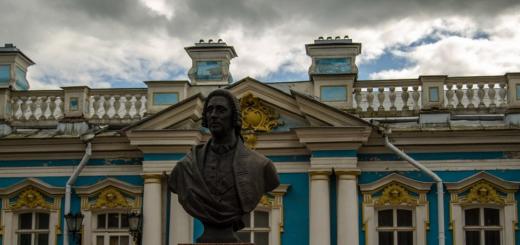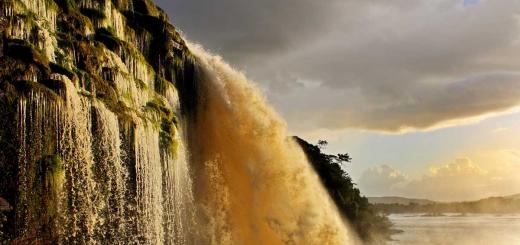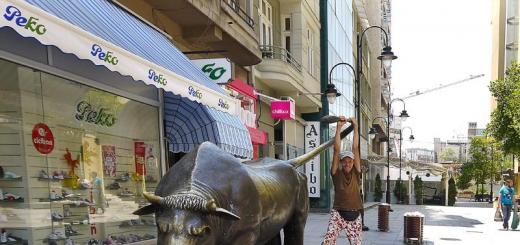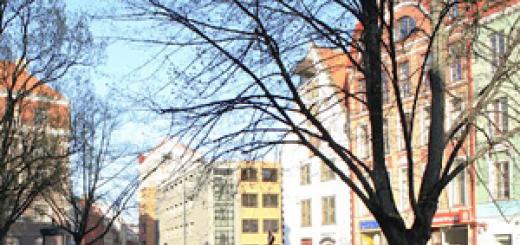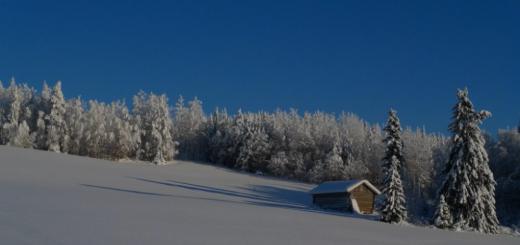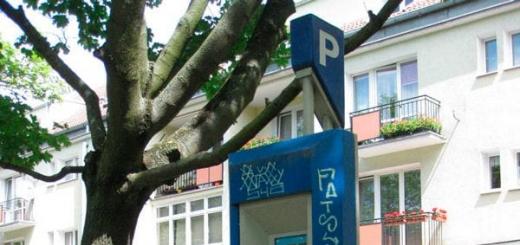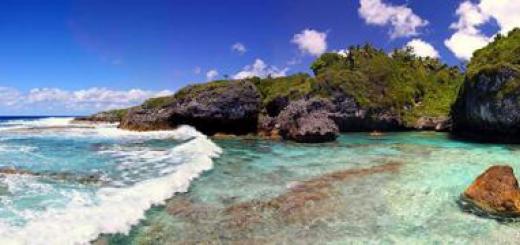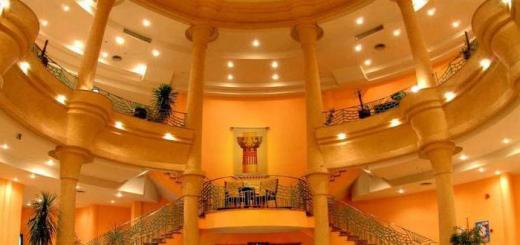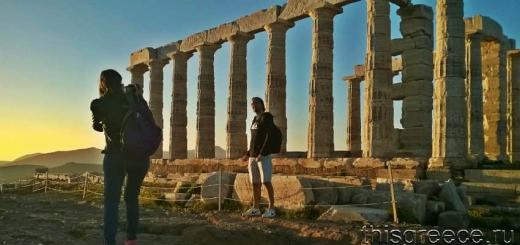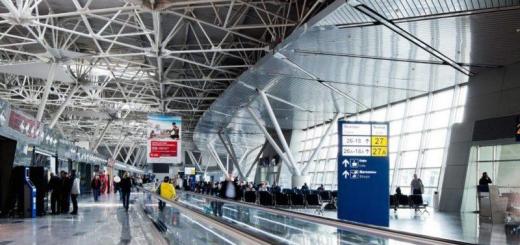Canaima (Venezuela) - exact location, places of interest, inhabitants, routes.
- Last Minute Tours around the world
Previous photo Next photo

In the southeast of Venezuela, there is the amazing Canaima National Park, the ancient lands of which have attracted travelers since ancient times. Officially, this place became a park only half a century ago, and already in 1994 Canaima was included in the UNESCO World Heritage List. And all thanks to the majestic Angel Falls located on its territory.
How to get there
The national park is located far from settlements, and getting by land can be quite problematic. It is possible to go on foot, but it will take a lot of time and require special preparation from travelers. Therefore, most of the tourists arrive in Canaima by a small plane from Caracas (or by canoe from the Orinoco Delta). In the latter case, the road will not only be fast, but also exciting.
Search for flights to Venezuela
Lodges and campsites
You can stay in one of the hotels located in the park, for example, Arekuna Camp Lodge or Parakaupa Camp Lodge. Most hotels are complexes of small palm houses that harmoniously fit into the surrounding landscape. There are cafes, restaurants and bars on the territory of the hotels, so tourists will not have to walk through the jungle, repeating the feat of James Angel.
Canaima National Park
What to see
Tepui
The park was made famous by the ancient tepuis, also called mesas or flat-topped mountains. In the language of the Pemon Indians, "tepui" means "home of the gods." There are not so many of them in the world, and it is in Venezuela, in the Canaima Park, that most of them are located.
Mysterious and bizarre tepuis are sandstones that formed in those distant times when Africa and South America were a single supercontinent. The most famous tepuis are the highest Roraima and Auyantepui.
In the 19th century, explorer Robert Schomburgk unsuccessfully tried to conquer Mount Roraima, but it was his account of the expedition that inspired Conan Doyle to create the famous novel The Lost World.
Angel Falls
Do you know which waterfall is the highest in the world? No, not Niagara. The highest is the Angel Falls, located in the Canaima National Park. Its height is 979 meters, it is so great that, before reaching the ground, the drops in the stream break into tiny particles and form a fog.
The waterfall received its "angelic" name in honor of the pilot James Angel. While landing on Auyantepui, his plane broke down, and the whole group had to go down the mountain on foot, the journey to the nearest settlement took 11 days. The fame of the pilot's adventures spread throughout Venezuela, and the waterfall was named after him.
A stream of water from the top of the table mountain Auyantepui rushes down into the Kerep River with great speed. Despite the fact that tepuis were considered the home of deities, the name Auyantepui translates as "Devil's Mountain".
It was founded on June 12, 1962, and in 1994 it was listed in UNESCO. Once upon a time there lived Indians who fought with each other, and in ancient times the word "Canaima" in the language of the Indians meant a murderer. Currently, more and more tourists from all over the world come here to see these amazing beauties. The national park is famous the world's tallest Angel Falls(Salto? Ngel), 979 meters high, named after the pilot James Angel, who first saw the waterfall from an airplane in 1935, who flew over the waterfall and landed on the top of the mountain in search of gold, where his plane got stuck in the jungle and he was near I went down for 11 days. His plane remained on the top of the mountain for about 33 years and can now be seen in Ciudad Bolivar. Water is overthrown from the largest table mountain Auyantepui, which means "Devil's Mountain" and flows into the Caroni River, which flows into the Orinoco River. The only way to get to the foot of Angel is to sail by boat for about 4 hours from Canaima, and another way, the easiest one, is to see it from a bird's eye view, flying around on a cornfield (on a small plane).

National parkCanaima consists of many impressive waterfalls: Golodrina, Acha, Ukaima and Sapo. In the Sapo waterfall, you can walk inside the waterfall and this is an indescribable pleasure that everyone should feel in reality. The property of Canaima is 3 palm trees in red water, the color of cognac or Coca-Cola, and pink sand, which cracks underfoot in an unusual way. Many exotic plants can be seen in the national park, including orchids, as well as mammals (anteaters, jaguars, monkeys and others) and a wider variety of birds (parrots, hummingbirds, toucans, eagles, and others). In the national park Canaima the Pemon Indians live, the population is about 2 thousand people, there is a school for children, restaurants, cafes, The best time to visit the park Canaima and Angel Falls- during the rainy season (April-November), when rivers and waterfalls are at their fullest.
Angel Falls and Canaima National Park are considered the main attraction of Venezuela.
Tour Canaima and Angel Falls 3 days 2 nights from Margarita Island: price from $ 450 per person.
 1 day tour: Departure at 8.30 am from Porlamar to Canaima (via Puerto Ordaz). Arrive in Canaima at about 11 o'clock in the afternoon. Pay
1 day tour: Departure at 8.30 am from Porlamar to Canaima (via Puerto Ordaz). Arrive in Canaima at about 11 o'clock in the afternoon. Pay
additionally entrance to the Canaima National Park 150 bsf per person. At the Canaima airport, you will be met by a guide, with whom you go to the posad, where you change your clothes and go to Angel by boats (canoes), the duration is about 4 hours, depending on the water level. On the way, you will have a lunch stop. All along the way we will be surrounded by landscapes of the national park, extraordinary mountains-tepuis. In the afternoon, we will sail to the camp on Raton Island, which is located at the base of the waterfall, where you will have dinner and a night in hammocks overlooking Angel.
Day 2 of the tour: Rise early in the morning and departure to Angel Falls, walk for about an hour through the forest jungle, come to the foot of Angel, where we swim, sunbathe, take photos and enjoy the stunning nature. They say that after swimming in Ankhel, you will get 10 years younger. Then we return to the camp, have breakfast, and sail back to Canaima at about 3 o'clock, Sail to Canaima at about 2 o'clock in the afternoon, settle in the settlement, have lunch. After lunch there is an opportunity to go sunbathing, swim in Canaima and take photos near the three famous palm-tree waterfalls Acha, Golodrina and Ukaima. Then dinner at 19.00 and the opportunity to walk in the park at night, watch the starry sky and a beautiful sunset.
Day 3 of the tour:... Rise early in the morning, at about 7 a.m. we go by boat for a walk along the Canaima waterfalls: Ukaima, Golodrina, and Acha and

Sapo, We land on the Anatolia island with pink sand, where you will see all the waterfalls from all sides, we head (about 15 minutes walk through the forest jungle) to the most beautiful and unusual Sapo waterfall, where we have the opportunity to walk inside the waterfall, Then we return back to the posad, re going,
If you wish, you can stay in the posad for 1 additional extra. night. we change clothes and take off at 12.00 from Canaima to Margarita Island(Porlamar) via Puerto Ordaz, we arrive at Margarita Island at about 2 pm.
Fly over Angel Falls on a maize (small plane) - 800 bsf per person.
Included: tickets Porlamar-Puerto-Ordaz-Canaima-Puerto Ordaz-Porlamar, Spanish and English speaking guides, meals, accommodation (1 night in a posad in Canaima, 1 night in hammocks near Anhel), all excursions.
Not included: airport tax (Porlamar-Canaima -45 bsf), entrance to the nat. Canaima park 150 bsf per person, alcoholic drinks, transfer
Prices for tours from Margarita Island:
FULL DAY from Margarita Island - $ 300
Briefly about the tour program: the plane is designed for 19 people.
Departure at 8 am from Porlamar to Canaima... Arrive in Canaima at about 10 o'clock, where the guide meets you and directs you to campamento (posada), where you change, leave your things in the special. storage room and go on canoe boats for a walk to the Canaima waterfalls, such as: Acha, Ukaima, Golodrina, Land on Anatolia island, where you will see pink sand and memorable views of all these waterfalls, then head, 15 minutes through the forest jungle to waterfall Sapo, where you pass inside it. The duration of the walk is about 2.5 hours. Return after a walk to the posad, where lunch awaits you, change, take pictures of about 3 famous Canaima palm trees that stand in the water and head to the airport, Departure to Margarita at about 4 pm, where on the way back the pilot makes several circles over Angel Falls, if climatic conditions allow (70% of 100% that the fly-over will be made). Having circled Angel several times, fly further to Margarita. Arrive at about 6 pm.
Included in the tour: Porlamar-Canaima-Porlamar tickets, lunch, guided tour of the falls, fly-over of Anhel (weather permitting), English and Spanish speaking guides.
Not included in the tour: airport tax 45 bsf., entrance to the nat. Canaima park -150 bsf., alcoholic drinks
Delta of the Orinoco River, Canaima, 2 days 1 night from Margarita Island -430 $



Briefly about the tour program:
1 day tour: Departure at 8 am from Porlamar to Canaima. You arrive in Canaima at about 10 hours, where the guide meets you and directs you to the posad, where you change and go on a boat trip to the Canaima waterfalls, the duration of the walk is about 2.5 hours. Return after a walk to the Posad, where lunch awaits you, change over, take pictures of about 3 famous Canaima palm trees that stand in the water, you can also buy souvenirs in local Indian shops and see how local Indian settlements live, and then head to the airport. Orinoco at about 4 pm, where on the way back the pilot makes several circles over Angel Falls, if climatic conditions allow (70% of 100% that the fly-over will be made), there you will be met and provided with a transfer (boat) to the camp located in the jungle of the river Orinoco, accommodation in campamento, where dinner awaits you.
Day 2 of the tour: After breakfast, we go on an Indian boat (canoe) on an excursion to local attractions, where we can observe the fauna and flora, sex piranhas, get acquainted with the local Varao Indians, whose houses stand on the water, their way of life, we can buy their local souvenirs and imagine ourselves in film "Lost". Lunch at campamento (caught piranhas included). Around 5 pm, return by plane to Margarita.
Included: Porlamar-Canaima-Porlamar tickets, lunch in Canaima, dinner, breakfast, lunch 2 days in Orinoco, all excursions to the waterfalls, the Orinoco Delta, overflying Ankhel (under favorable climatic conditions), all transfers, English speaking guides. and isp. languages.
Not included: airport tax 45 bsf., entrance to Canaima lagoon -150 bsf., alcoholic drinks
Excursion - Canaima and Angel National Park 3 days 2 nights from Ciudad Bolivar, Puerto Ordaz - $ 300 (group of 4 people - we provide a discount)
Our company can buy air tickets for you in advance:
Caracas-Puerto Ordaz-Caracas - from $ 50
Caracas-Puerto Ordaz- Margarita- from 50 $
We recommend to take with you : swimsuit, beach clothes (cap, shorts, T-shirt + warm clothes in the evening), towel, sunscreen, mosquito spray, beach slippers, sneakers, bags (closable) for storing the camera, if there is a special waterproof case for the camera - be sure to take ... It is not recommended to take with you everything related to cutting objects (knife, tongs, etc.) - it is not allowed at the airport, it is better to take alcohol with you, since prices in Canaima are 6 times too high.
If you need a Spanish translator, we can provide for an additional fee.
Canaima National Park is located on the east coast of Venezuela in the state of Bolivar. The park was founded on June 12, 1962. The area is about 30,000 km². In 1994, Canaima National Park was listed as a UNESCO World Heritage Site.
It is one of the twenty countries in the world with the richest biological diversity and strikes the imagination with unique landscapes inherent only in this area, as well as the species diversity of flora and fauna.
It is here in Canaima Park that the tallest in the world is located. The rarest mountain landscapes of tepui (the so-called "table mountains"), which are flat-topped sandstones, were formed in that distant era when South America and Africa were one continent.
The most famous tepuis of the park are Roraima, Auyantepui, Sierra Neblina. Climbing some tepuis (of which there are more than 50 in the park) became possible only at the very end of the 20th century.
Conquering the majestic tepuis of Venezuela, the researchers were amazed at the similarity of the landscapes for the first time coming off the human eye with the fantastic worlds of Arthur Conan Doyle, who created his "Lost World" under the impression of these primitive places of Latin America. Of the plants collected on the tepui expedition, 98% were unknown to 20th century botanists.
In Canaima National Park, where the spurs of the Guiana Highlands form isolated trunk mountains with almost vertical slopes, and the water in the rivers after the rains turns bright red and black from washed out sandstone, there are plants and animals endemic that do not live anywhere else on the planet.
In the park, you can see valleys covered with carpets of carnivorous orchids that feed on small animals. Meet the rarest caimans and three-legged owls, the world's largest dragonflies and tarantulas longer than 35 cm and predatory ants that easily bite down on tree branches. Therefore, enjoy the beauty of the park, preferably in the daytime, accompanied by a guide.
Canaima National Park is the best place for ecological tourism, because only here you can see the most ancient landscapes of the Earth, which are more than 2 billion years old. Only in this truly fantastic place do polar mosses coexist with African palms. From the cracks in the rocks, bright brown shoots soar up a few meters, which are the root system of the rarest plants, similar to giant artichokes. And on the tops of the tepui, more than 200 species of ferns of the Mesozoic era grow, the appearance of which has not changed for more than 180 million years.
Canaima National Park - PHOTOS













Canaima is a national park of Venezuela, known to the whole world because of the Angel - the first among the highest waterfalls in the world.
General information on Canaima
- Full name: "Canaima" National Park (Spanish. Parque Nacional Canaima).
- Region: Bolivar State, Venezuela.
- IUCN category: Canaima - II (national parks).
- Date of foundation: June 12, 1962
- Area: 30 thousand km2.
- Relief: mountainous, part of a mountain plateau with mononocks, dotted with mountain gorges, rivers and waterfalls.
- Climate: subequatorial.
- Official website: //salto-angel.com/
- The purpose of its creation: preservation for our descendants of unique geological formations - tepuis and the highest and perhaps the most beautiful waterfall in the world Angel, protection of natural complexes of humid savannas, rain equatorial and gallery forests in the floodplains of the rivers of the Orinoco basin.
- Visiting Canaima - paid
Canaima - information for park visitors
Canaima National Park lies in the southeast, in the state of Bolivar, the municipality of Gran Sabana on the border with Brazil and Guyana.
In the very center of the park is the administrative center, the town of Canaima with a population of 1200 people. It has small hotels and restaurants, as well as a tiny airfield serving locals and tourists. It receives daily charter flights from Caracas.
The park is open all year round, but a more favorable excursion period is from the first ten days of May to November, when the rainy season begins and the waterfalls located in the protected area become the most spectacular. The visit is paid.
Ground infrastructure and transport links are poorly developed in the nature conservation area, therefore, one can get into the depths of the "Canaima" mainly on small aircraft. On the other hand, the aircraft offers breathtaking landscapes.
Visitors to the park can go canoeing on the lake, rafting on small rivers, and walking along numerous paths, such as a special path between water streams and a rock. On a long hike with local guides, you can see all the sights of the park, visit the Indian Pemon tribe - the indigenous inhabitants of this territory.
History of Canaima Park
From time immemorial, the aborigines of the southeast of Venezuela, the Indian tribe Pemon, knew about the existence of an area with mesas and waterfalls,  some of which, thanks to ancient volcanic activity, carried colored water. These mountains were called "tepui", that is, "home of the gods." The Indians considered the territory to be mystical.
some of which, thanks to ancient volcanic activity, carried colored water. These mountains were called "tepui", that is, "home of the gods." The Indians considered the territory to be mystical.
The first European, who in 1595. saw a huge waterfall and described it in his books, became the English traveler and writer Sir Walter Raleigh. Later, in his reports, the conquistador Fernando Berrio mentioned "a stream of clear water falling from the sky."
Then there was no information about tepuis and waterfalls for three centuries, and only in 1910. the waterfall was again discovered by the lieutenant of the Venezuelan fleet, the Spanish explorer E. Sanchez la Cruz.
The world learned about this amazing territory after the flight over it by American pilot James Crawford Angel in 1933.
In 1937. he returned here not alone, but as part of an expedition that tried to survey tepui with a waterfall "a mile away," as Angel said. Unfortunately, the plane, having landed on the tepui, fell into a quagmire. Travelers only two weeks later were able to reach first to the village of the Indians, who warmed and fed them, and then to civilization.
In 1949. another expedition headed by the former military correspondent, the American Ruth Robertson, headed to the waterfall on motorboats along the Churun River. Later in National Geographic there was an article by Robertson "Journey through the jungle to the highest waterfall in the world." The Spanish name - Angel - the waterfall received in honor of James Angel.
In 1962. Tepui, Angel Falls and the surrounding area were declared Canaima National Park. It is the second largest in the country. In 1994. it is included in the UNESCO List of World Heritage Sites.
In 2009. by order of the President of Venezuela, the waterfall was renamed Kerepakupay- this is what the locals called him long before the appearance of the American pilot. However, on the maps of all countries of the world, Kerepakupai is still designated as Angel Falls.
Walk in tepui and park
Between the rainforest equatorial forests of the Amazon and Orinoco river basins, the Roraima Plateau stretches - the south of the Guiana Highlands. It is surrounded by a wall of rocky Pakaraima mountains. Most of the 2000-meter steep mountains have flat peaks. The world knows the table mountains under the Indian name "tepui".
On the tops of many mountains there are deep karst craters up to 300m in diameter. They were formed due to the collapse of the vaults of the internal cavities, made by underground rivers. The most famous and deepest of the caves is Abismo Gui Collet. Numerous rain-fed rivers flow from the edges of the tepuis, creating beautiful waterfalls and deep canyons.
The plateau was named after one high mountain - Roraima, it is located on the border of Guyana, Venezuela and.
Sarisarinyama with deep canyons at the top was named for the analogy with the crunch of jaws that the evil demon dwelling on its top makes.  Auyantepui in the language of the Pemon tribe means "the mountain of the devil." Its area is the largest of all the tepuis in the park - 715 km2. It is from here that Angel Falls begins its rapid descent to the ground.
Auyantepui in the language of the Pemon tribe means "the mountain of the devil." Its area is the largest of all the tepuis in the park - 715 km2. It is from here that Angel Falls begins its rapid descent to the ground.
There are many other interesting mountains on the territory of the reserve park, almost each of them has its own name. Cerro Autana is a mountain sacred to the Pemon Indians, they believe that this massif, eaten by karst caves and funnels, is the trunk of the tree of life, through which the juices of the Earth flow. The surface of Cerro Pintado ("painted mountain") is covered with ancient petroglyphs that have no analogues in the world.
The Canaima Lagoon, after which the park was named, is located in the northwest of the protected area. The wide expanse of water is flanked by a cream-colored beach.
With noise and splashes, six majestic waterfalls rush down from the mesas: Acha, Golondrina, Ukaima, Sapito, Sapo and Ara.
Natural wonders and fun in Canaima
The main attraction of Canaima Park is the Kerepakupai waterfall (Angel),  he is the tallest on the planet. In the Pemon language, the waterfall is called Kerepakupai-Vienna, which means "the waterfall of the deepest place."
he is the tallest on the planet. In the Pemon language, the waterfall is called Kerepakupai-Vienna, which means "the waterfall of the deepest place."
Jets of water, falling from a great height, are sprayed into the air, turning into fog. This suspension of the smallest water particles can be felt ten kilometers from the waterfall. The streams of the waterfall flow into the Gauja River, better known as the Kerep, and then into the Churun River.
Tepui - remnant hills (monadnock), fragments of a vast plateau that stretched in the distant past from the coast to the borders of the basins of the Rio Negro, Amazon and Orinoco rivers. These amazing mountains were formed in the Precambrian period, when there was still a single huge supercontinent Gondwana with Africa. Ancient igneous rocks (granite) are covered with layers of sandstone and lava, and they got their present shape thanks to centuries of erosion.
- 979 meters - The total height of the Kerepakupai waterfall (Angel)
- 807 meters - The total height of the continuous fall of the Kerepakupai waterfall (Angel)
- 672 meters - Depth of the Abismo-Gui-Collet cave
More about the reserve:
- Angel Falls, Auyantepui and lagoon canaima known throughout the planet.
- Pico de la Neblina, or "mountain of mists" - clouds constantly hang over it.
- The sheer wall of Auyantepui rises above the rainforest.
- Pale Saki is an arboreal inhabitant of the tropical forests of the northeastern part of the South American continent.
- Emerald hummingbird (Chlorostilbon sp.) Pollinates a flower of the genus Strelitzia sp. preventing him from dying.
- The banana songbird (Coereba flaveola) is only about 11cm long and inhabits the rainforests of South and Central America, feeding on berry juice, insects and nectar.
The flora of the park
The vegetation of "Canaima" is mainly equatorial rain forests. However, the flora on the summits of the tepuis is significantly different. As a rule, there are isolated biogeocenoses called Pantepui. They occupy the surface of the mesas plateau from 1500m.
The processes of biological isolation are characteristic of Pantepui, 65% of the park's territory can be classified as botanical refugium (from Latin refugium - refuge, a place where a species has survived or is going through an unfavorable period, during which it has already disappeared over large areas). There is a very high degree of endemism (33%) and due to the common past of Africa and South America, the tepui peaks have species characteristic of the African continent and the Andes mountainous regions.
Exceptional species diversity is observed on isolated flat tops. So, of the 2322 species of vascular plants in the northern parts of South America, representatives of 630 genera are found on tepuy, of which 766 species are endemic, and 65 species generally live only here.
The national park is spread over four phytogeographic regions, each with its own set of characteristic and endemic taxa.
For example, at the moment there are 20 species of bamboo of the genus Myriocladus among the endemics of the tepuy summit plateaus.
Also on tepuys you can find endemic species of Bromeliaceae, Gentianaceae, Haemodoraceae, Rapateaceae, Xyridaceae, Magnoliaceae, Sapindaceae and Myrtaceae.
Canaima animals
The fauna of "Canaima" - the park is no less diverse than the flora. Of the mammals, 186 species live in the protected area, they mainly occupy the lower slopes of the mountains. This includes 9 primate species such as the red howler (Alouatta seniculus), the three-banded night monkey (Aotus trivirgatus), the collar jumper (Callicebus torquatus), the black-headed uakari (Cacajao melanocephalus), the chestnut-colored capuchin (Celedaus ); 5 feline species such as jaguars (Panthera onca) and cougars (Puma concolor).
The ubiquitous common iguanas can be found everywhere in the park  (Iguana Iguana) and tegu (Tupinambis spp.).
(Iguana Iguana) and tegu (Tupinambis spp.).
In the park, you can often find a mouse opossum (Marmosa tyleriana) and a white-eared one (Didelphis albiventris), a long-tailed weasel (Mustela frenata), a three-toed sloth (Bradypus tridactylus) and a variety of bats (Microchiroptera). Of the endemic species, representatives of the cricetidae family, such as Podoxymys roraimae, are found exclusively on Roraima.
The territory of "Canaima" is inhabited by a large number of birds, out of 628 species 41 are endemics of the park, for example, the Venezuelan tinamu (Crypturellus ptaritepui), the red-shouldered red-tailed parrot (Pyrrhura egregia), the green passerine parrot (Nannopsittaca panychlora), the Venezuelan gibbet (Campylopterus hyperythrus), gray-footed saber-wing (Campylopterus duidae), peacock coquette (Lophornis pavoninus), Tepuy golden-throated hummingbird (Polytmus milleri), brown diamond (Heliodoxa roi xanthogonys), white-chinned forest filidor (Automolae)
Reptiles and amphibians abound on the tops of the tepuis, such as spearhead snakes (Bothrops spp.), Coral snakes (Micrurus spp.), Common boas (Boa constrictor) and bushmasters (Lachesis muta).
The park's rivers and Canaima lagoon are teeming with tropical freshwater fish, and a huge number of butterflies flutter over the water.
Tepui of Venezuela with Angel Falls literally bewitches visitors of the national park, forcing tourists to return to Canaima again and again.
Canaima is a national park of Venezuela located in the state of Bolivar. Canaima is truly an outstanding park. Its area is more than 30,000 km 2, due to which it is on the 6th place in terms of size among the world's reserves. Also Venezuela is among 20 countries with the richest flora, fauna, unique terrain, unique plants and animals. Most of the park's jungles can be walked through with a well-sharpened machete, but the views from the mountains are well worth the effort.
Throughout the park in the middle of the jungle, as if giant ships of humanoids ascend large dining heights, steep stone walls descending into the jungle. Canaima's inimitable mesas end in large plateaus. The mountains were formed due to the erosion of the earth and rocks. Locals call these plateaus tepuis. There are more than 50 tepuis in the park, but among the rest, tepuis are especially famous: Auyan tepui, Roraima, Sierra Neblina. Such a number of flat mountains on Earth are nowhere else to be found. The most famous mountain is Auyan Tepuy with the great Salto Angel waterfall located at an altitude of 979 meters. The waterfall was first discovered by pilot Jimmy Angel in 1936, who, looking for gold, landed a light plane on the top of the mountain from which the waterfall was falling. The waterfall was named in his honor. It is also worth noting the Sapo waterfall, 20 meters high, but at the same time it is 120 meters long. Under the streams of the waterfall, at a height of one and a half meters, there is a pedestrian path along which you can walk without fear for your health. Tourists can also fly over the tepui and waterfalls, or land by helicopter on the Roraima Plateau. Hiking climbing this mountain can take about 2 days, but the views from the mountain will not be forgotten soon. In 1912, Arthur Conan Doyle took part in an expedition to these places. Influenced by fantastic landscapes, he wrote his one of the most famous books - "The Lost World".
In addition to impressive ancient landscapes, Canaima is extremely rich in flora and fauna. Canaima National Park is one of the best ecotourism destinations. More than 900 species of plants grow in the forests and valleys of the park, 500 species of birds live, such as: eagle, falcon, parrot, the smallest bird, hummingbird, toucan. 70 species of reptiles and approximately 50 amphibians. Many mammals: jaguar, puma, tapir, ocelot, anteater, agouti, otter. During the rainy season, the rivers and waterfalls of the park are at their most beautiful. In Canaima, there are many amazing and rare animals and plants: orchids that eat small insects, carnivorous ants, the largest spiders and dragonflies, many species of fern grow on tepuis.
Canaima National Park is one of the best places for ecotourism, as it contains the oldest landscapes on Earth. In the tropical forests and savannas of the park, there are about 900 species of plants, including more than 500 species of orchids, over 500 species of birds (eagles, falcons, parrots, toucans, hummingbirds), 72 species of reptiles and about 50 species of amphibians, 150 species of mammals (jaguars , cougars, tapirs, ocelots, bakers, anteaters, agouti, monkeys, giant otters). The park is best visited from April to November, when the rainy season passes and the rivers with waterfalls are in full swing.
A wonderful infrastructure has been functioning in the park for more than a dozen years. In the city of Canaima, stretched out on the shores of the lake of the same name, you can better get acquainted with the park in the tourist center. The tourist center presents all kinds of attractions and ways to get to them: hiking to the peaks of the tepui, jeep safaris, kayaking, swimming in the waterfalls, or perhaps even someone wants to fly in a light plane over Angel Falls.

